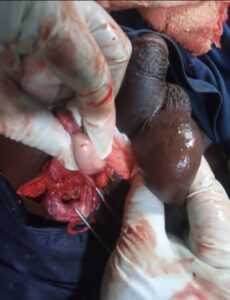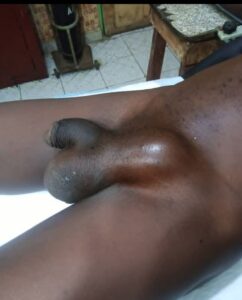
ALTH

ALTH
“`UNDESCENDED TESTICLE“`
CAUSES, SYMPTOMS AND TREATMENT
WHAT IS UNDESCENDED TESTICLE?
An undescended testicle (cryptorchidism) is a testicle that hasn’t moved into its proper position in the bag of skin hanging below the penis (scrotum) before birth. Usually just one testicle is affected, but about 10 percent of the time both testicles are undescended.
An undescended testicle is uncommon in general, but common among baby boys born prematurely.
The vast majority of the time, the undescended testicle moves into the proper position on its own, within the first few months of life. If your son has an undescended testicle that doesn’t correct itself, surgery can relocate the testicle into the scrotum.
WHAT ARE THE SIGNS AND SYMPTOMS?
Not seeing or feeling a testicle where you would expect it to be in the scrotum is the main sign of an undescended testicle.
Testicles form in the abdomen during fetal development. During the last couple of months of normal fetal development, the testicles gradually descend from the abdomen through a tube-like passageway in the groin (inguinal canal) into the scrotum. With an undescended testicle, that process stops or is delayed.
WHAT ARE THE CAUSES?
The exact cause of an undescended testicle isn’t known. A combination of genetics, maternal health and other environmental factors might disrupt the hormones, physical changes and nerve activity that influence the development of the testicles.

ALTH
WHAT ARE RISK FACTORS?
Factors that might increase the risk of an undescended testicle in a newborn include:
• Low birth weight
• Premature birth
• Family history of undescended testicles or other problems of genital development
• Conditions of the fetus that can restrict growth, such as Down syndrome or an abdominal wall defect
• Alcohol use by the mother during pregnancy
• Cigarette smoking by the mother or exposure to secondhand smoke
• Parents’ exposure to some pesticides.
WHAT ARE IT’S COMPLICATIONS?
In order for testicles to develop and function normally, they need to be slightly cooler than normal body temperature. The Complications of a testicle not being located where it is supposed to be include:
*Testicular cancer.* Testicular cancer usually begins in the cells in the testicle that produce immature sperm. What causes these cells to develop into cancer is unknown. Men who’ve had an undescended testicle have an increased risk of tesprovideDer.
The risk is greater for undescended testicles located in the abdomen than in the groin, and when both testicles are affected. Surgically correcting an undescended testicle might decrease, but not eliminate, the risk of future testicular cancer.
*Fertility problems.* Low sperm counts, poor sperm quality and decreased fertility are more likely to occur among men who’ve had an undescended testicle. This can be due to abnormal development of the testicle, and might get worse if the condition goes untreated for an extended period of time.
Other complications related to the undescended testicle include:
*Testicular torsion* . Testicular torsion is the twisting of the spermatic cord, which contains blood vessels, nerves and the tube that carries semen from the testicle to the penis. This painful condition cuts off blood to the testicle.
If not treated promptly, this might result in the loss of the testicle. Testicular torsion occurs 10 times more often in undescended testabntesprovidnormal testicles.
*Trauma*. If a testicle is located in the groin, it might be damaged from pressure against the pubic bone.
*Inguinal hernia.* If the opening between the abdomen and the inguinal canal is too loose, a portion of the intestines can push into the groin.

ALTH
HOW DO I KNOW IF MY TESTICLE IS UNDESCENDED?
The main signs is you can’t see or feel the testicle In the scrotum when both are undescended, the scrotum looks flat and smaller than you’d expect it to be. Some boys have what’s called a retractile testicle. If may move up into their groin when they are cold or scared but moves back down on its own.
CAN UNDESCENDED TESTICLE CORRECT ITSELF?
The vast majority of the time, the undescended testicle moves into the proper position on it’s own. Within the first few months of life. If your son has an undescended testicle that doesn’t correct itself visit our Medical professional at Adebayo Living Tower Hospital

ALTH
WHEN CAN I SEE DOCTOR OVER MY UNDESCENDED TESTIS?
An undescended testicle is typically detected when your baby is examined shortly after birth. If your son has an undescended testicle, ask or visit our professional Medical Doctor at Adebayo Living Tower Hospital to know how often your son will need to be examined. If the testicle hasn’t moved into the scrotum by the time your son is 4 months old, the problem probably won’t correct itself.
OUR DIAGNOSIS AND TREATMENT FOR AN UNDESCENDED TESTICLE AT ADEBAYO LIVING TOWER HOSPITAL
Treating an undescended testicle when your son is still a baby might lower the risk of complications later in life, such as infertility and testicular cancer.
Older boys from infants to pre-adolescent boys who have normally descended testicles at birth might appear to be “missing” a testicle later. This condition might indicate:
A retractile testicle, which moves back and forth between the scrotum and the groin and might be easily guided by hand into the scrotum during a physical exam. This is not abnormal and is due to a muscle reflex in the scrotum.
An ascending testicle, or acquired undescended testicle, that has “returned” to the groin and can’t be easily guided by hand into the scrotum.
If you notice any changes in your son’s genitals or are concerned about his development, Visit our Medical professional Surgeon at _Adebayo living tower Hospital_ the undescend in the scrotum.
Treatment before 1 year of age might lower the risk of complications of an undescended testicle, such as infertility and testicular cancer. Earlier is better, but it’s recommended that surgery takes place before the child is 18 months old.

ALTH
An undescended testicle is usually corrected with surgery. Our medical professional surgeon carefully manipulates the testicle into the scrotum and stitches it into place (orchiopexy). This procedure can be done either with a laparoscope or with open surgery.
When your son has surgery will depend on a number of factors, such as his health and how difficult the procedure might be. our medical professional medical surgeon at Adebayo living tower Hospital will likely recommend doing the surgery when your son is about 6 months old and before he is 12 months old. Early surgical treatment appears to lower the risk of later complications.
“`I.. C.. T Department“`
ADEBAYO LIVING TOWER HOSPITAL
ALTH

Recent Comments